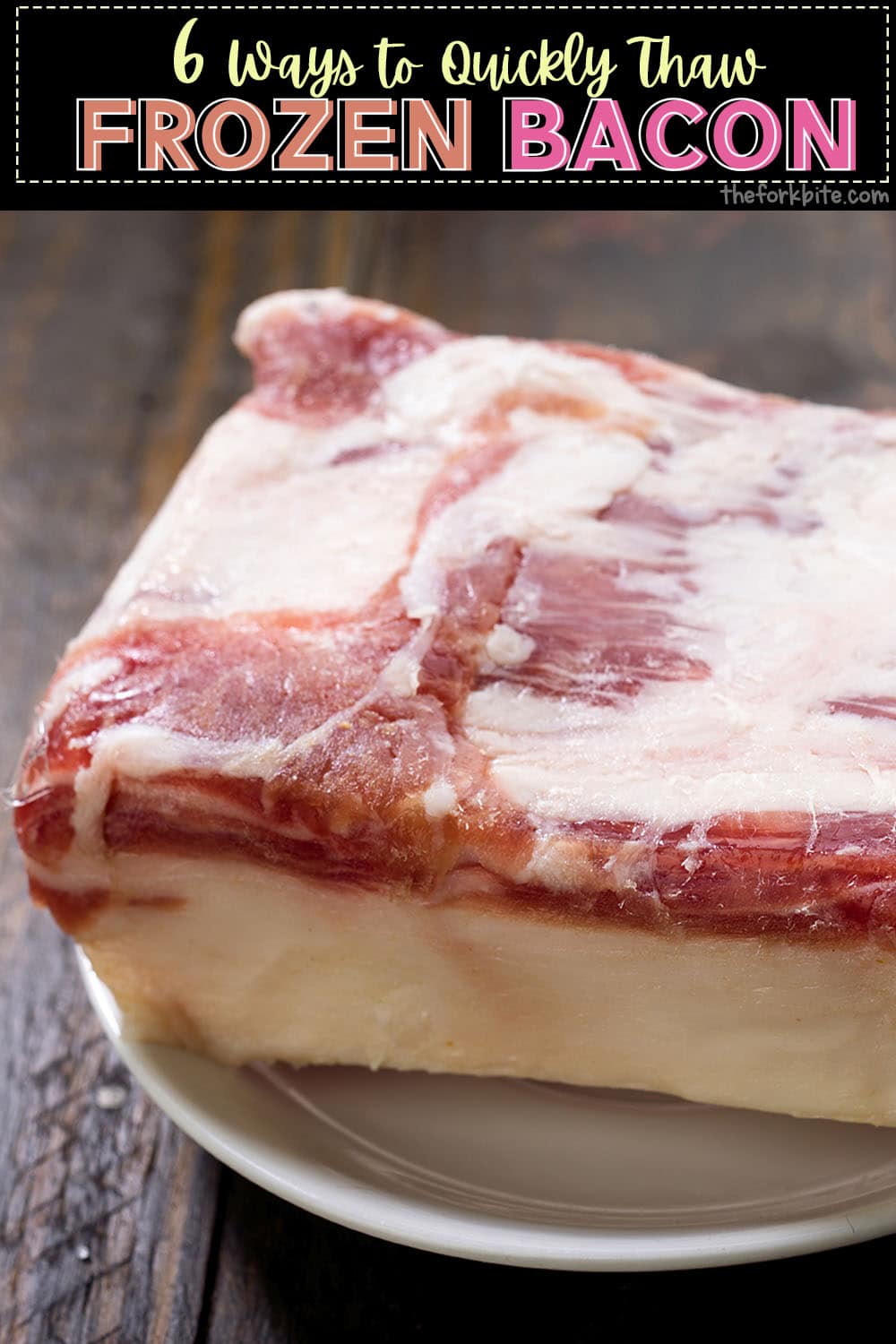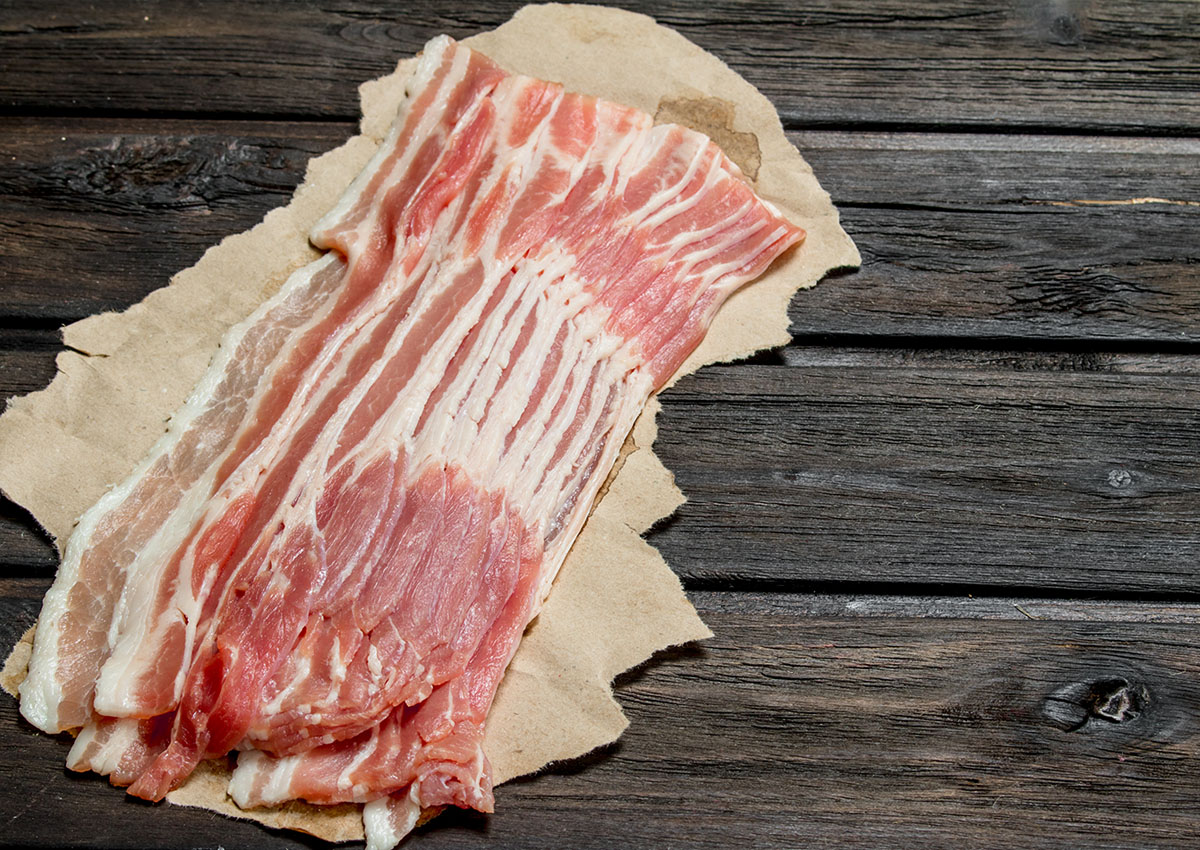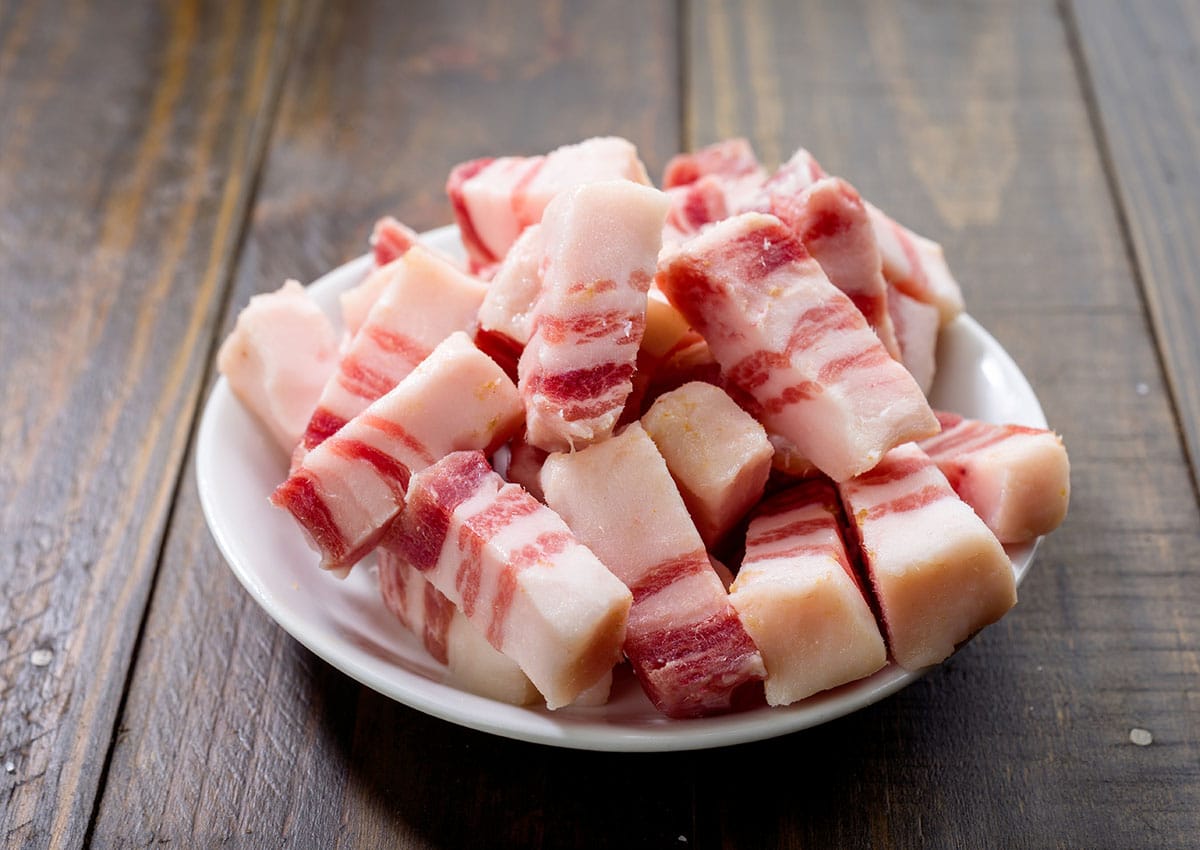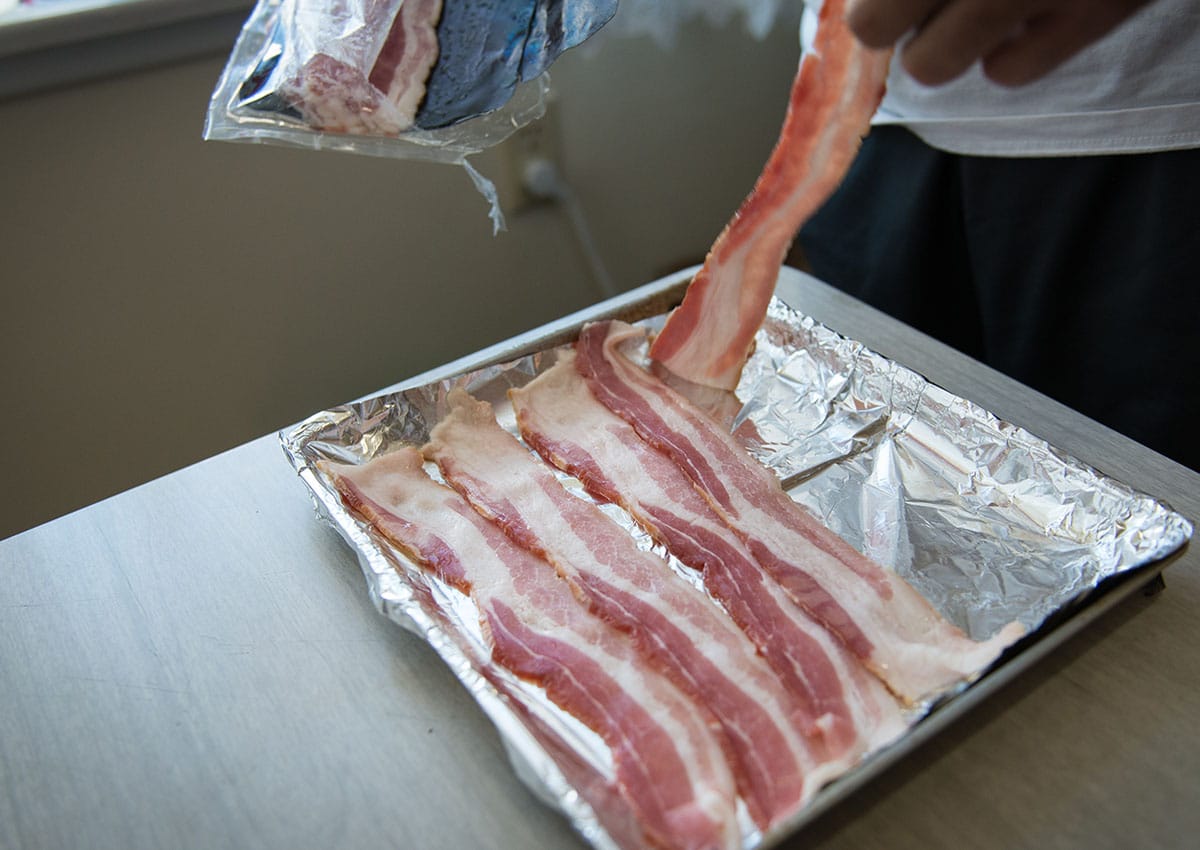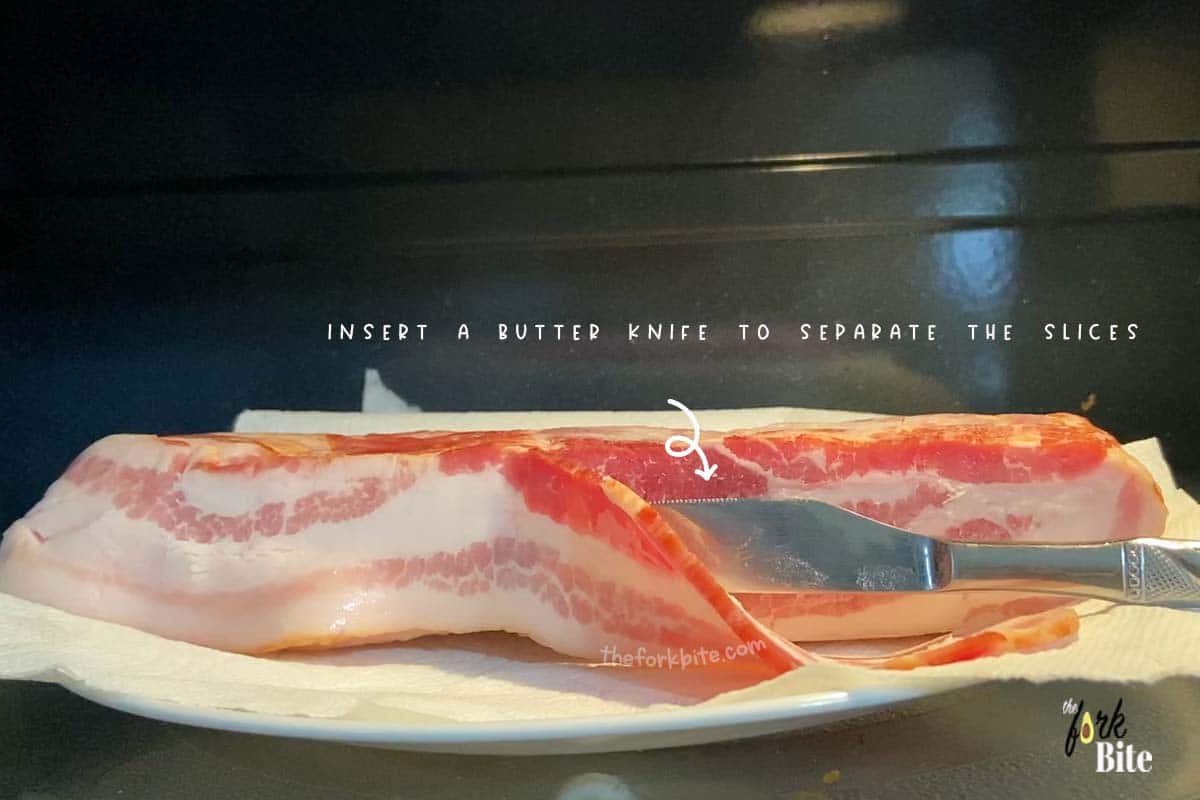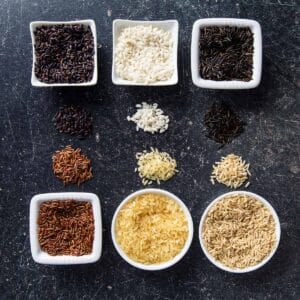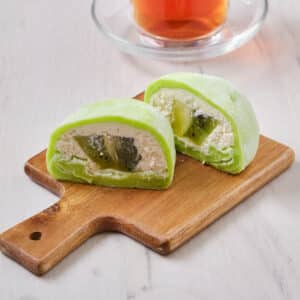How to quickly thaw bacon? Whether it's in your microwave or stovetop, defrosting it in the right way is vital for maintaining the taste.
I've spent a lot of time on this, and I would like to share my findings with you, so please read on.
Bacon is one of the scrummiest foods ever. The tantalizing smell of it being fried or grilled at breakfast time is one of the best things ever for starting your mouth watering in anticipation. By why limit the experience to breakfast time?
You can enjoy it anytime and anyhow. It's great in sandwiches, on burgers, and as a tasty wrap around other proteins like chick breasts and pork tenderloin.
It's so delicious and so versatile that it's no wonder we like to buy it in bulk - and saving money in the process is an added benefit.
Of course, you can't cook it all at once, so knowing how best to freeze it and defrost it without detracting from its great flavor is essential.
However you do it, whether it's in your microwave or pan-fried on your stovetop, defrosting bacon in the right way is vital for maintaining the taste.
How to freeze uncooked bacon
Before we talk about defrosting bacon, it would make sense to chat about freezing it first.
- Freezing uncooked bacon is simple. It is recommended to leave it in its original store-bought packaging, wrapping it tightly in aluminum foil.
- Place it inside a Ziploc freezer bag, and evacuating as much air out of the bag as possible.
The double and treble packaging will help to avoid the danger of freezer burn.
How to freeze cooked bacon
Cooked bacon, and by this, I mean cooked rashers of bacon, can be frozen in a similar way to that mentioned above, minus of course, the original packaging.
You could, however, decide that you want to freeze cooked rashers individually.
To do this, you will need to lay each rasher out onto a baking or cookie sheet and flash freeze.
Once they are frozen, you can then tip them into a large Ziploc freezer bag and freeze the whole thing. That way, when you just want one or two rashers at a time, they will be easily accessible.
Safety note
Never leave perishable foods (including bacon) outside at room temperature for longer than two hours.
If kept inside the fridge, you can keep an opened packet of bacon for up to 3 days. If it is unopened, then it's best used by its "used by" date.
Let us now get on with the main thrust, namely the six best ways of thawing frozen bacon.
Important things to know before you thaw bacon
Before you set about defrosting frozen bacon, there are some key things you need to be aware of if you want to get the best results.
The first thing to appreciate is that you should never defrost bacon at room temperature. If you do, you will be opening the door to the so-called "Danger Zone."
The "Danger Zone" is the name given by the US State Department of Agriculture to the range of temperatures within which harmful, food poisoning bacteria will proliferate on fresh (or defrosting, frozen) foodstuffs. The range stretches from 40°F to 140°F.
The second thing to understand is that you should only ever use recommended defrosting methods because these will help to lower the risk of contaminating food.
Other useful tips
- Store bacon in its original packing when that packing is unopened.
- Once the original packing has been opened, put any leftover bacon into a Ziploc bag.
- Cook bacon straightaway once it has been defrosted.
If you have any leftover cooked bacon that has gone cold and want to reheat it, you'll find a comprehensive guide here.
How to quickly thaw bacon
Okay, let's get down to it. It's time to discuss the six best and safest ways of defrosting frozen bacon.
They are as follows:
- Defrosting it overnight in your refrigerator
- The cold water-bath method
- Using your microwave to defrost it
- Defrosting bacon in a skillet
- Defrosting bacon and a cast-iron frying pan
- Cutting the bacon into lardons
Let's take them one at a time.
Method 1 Defrosting overnight in your fridge
The first thing to be mindful of, as I mentioned before, is allowing your frozen bacon to thaw overnight in your refrigerator.
It is the safest method of all the six options. The only thing is remembering to do it in advance in preparedness for next morning's breakfast or lunch, or whatever.
It allows the bacon to defrost without entering the dreaded "Danger Zone."
If you bought the bacon in a solid chunk for later slicing, then defrosting it completely could take longer. You may not only need to leave it in your fridge overnight but a few hours into the day as well.
Drawing comparisons from the USDA website, they advised the following:
- A whole frozen turkey requires one full day for every five pounds
- One pound of frozen minced beef requires one full day, and by that, I assume they mean 24 hours.
Another thing not to lose sight of is that if the bacon has been kept in a chest freezer at a colder temperature than in your fridge freezer, it may take longer to defrost.
Here are the steps to follow:
Step 1
Take the frozen bacon out of your freezer and remove any packaging.
Step 2
Transfer the frozen bacon into a container and put it into your fridge, and leave it there overnight to defrost.
After being in the fridge for between eight and twelve hours, it will have thawed completely and ready for cooking.
If you are not going to cook it immediately, it can be left in your fridge for up to one week.
Pros
- It is the safest way to defrost bacon as it prevents exposure to any harmful bacteria.
- This method is ideal when planning well in advance.
Cons
- It means thinking ahead. Because it takes anywhere between eight and twelve hours, this method is no good if you want to cook the bacon more or less immediately.
Method 2 Defrosting in a cold water bath
This method of defrosting bacon is a halfway house between refrigerating it overnight and microwaving it.
Follow these steps:
Step 1
Transfer the bacon either still inside its original packing or in the Ziploc bag to ensure there will be no leaks, into a bowl of cold water.
Step 2
When the water becomes too cold, as it will initially due to the frozen bacon cooling it, pour it away and refill with more cold water. Do this as often as necessary.
Step 3
Continue to soak in cold water for between 10 and 15 minutes or until the bacon has completely thawed.
If the bacon has not totally thawed, carry on soaking it in cold water at five-minute intervals. Of course, the length of time will vary depending on how much bacon you are defrosting.
You can accelerate the process considerably if you place the bacon under running cold water from the tap.
However, it will still take several minutes, and in the process, you will be wasting water.
Pros
- Far quicker than defrosting overnight in the fridge.
Cons
- If the process takes too long or it is left out for longer than two hours, there is a high probability that harmful bacteria will begin to form
Method 3 Defrosting in the microwave
There is absolutely no doubt that using the microwave to defrost bacon is the quickest method.
The steps to take:
Step 1
Transfer the bacon from the freezer onto a microwave-safe plate or container.
Step 2
- Using the defrost setting if your microwave has one, or turning the power setting down to 30%, if it doesn't, begin defrosting.
- Defrost in short 60 second bursts. It can take anywhere from 3 to 5 minutes, depending on the quantity of bacon you are defrosting. (I defrosted a 1.5 lbs frozen bacon for about 3 minutes).
- Once it has thawed completely, you should cook the bacon immediately.
Never use a high setting on your microwave when defrosting bacon. It will burn on the outside, and the inside will still be frozen.
Pros
An ideal method for defrosting bacon when you want to cook it as soon as possible without planning ahead
Cons
If you microwave it for too long or the power setting is too high, the bacon may start to cook.
Method 4 Defrosting (and cooking) using a skillet
Another way of defrosting frozen bacon quicker than overnighting it in a fridge is to use a skillet, provided, of course, your skillet is large enough.
Step 1
Transfer the bacon out of the freezer, remove any packaging, and transfer it into a large skillet.
Step 2
Place the skillet on your stovetop over a medium-low heat setting.
Step 3
As the bacon begins to defrost, you will be able to separate each strip. If you want to speed up the defrosting process, cover the pan with a lid or some aluminum foil.
Step 4
Flip each of the rashers over, in turn, to ensure they are defrosted on both sides
If you carry on heating the bacon for 15 to 20 minutes, it will become nice and crispy.
Method 5 Defrosting in a stainless steel frying pan
Faster than defrosting overnight in a fridge, using a stainless steel frying pan (like the All-Clad sauté pans) is another option. They are designed to conduct heat efficiently and do double duty to defrost food faster.
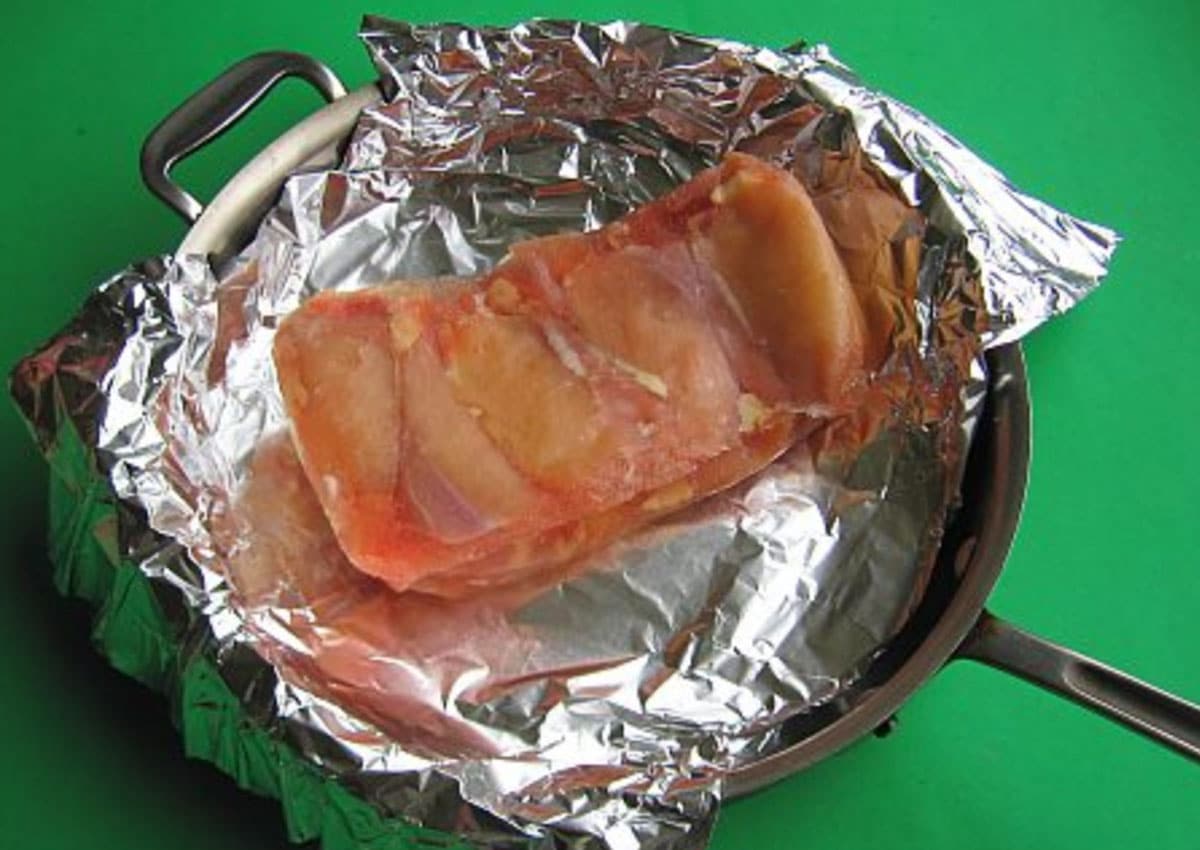
Step 1
Take your heavy frying pan out of the cupboard and line it with aluminum foil.
Step 2
Transfer the frozen bacon into the frying pan, wrapped or unwrapped - your choice.
Step 3
Put the pan on the stovetop and allow it to stand until it thaws, turning it over halfway through to ensure it defrosts evenly.
Note: Ensure the maximum surface area of food is touching the pan after flipping it over by pressing it down nicely.
Using this method is best employed when the room temperature is reasonably stable and within the USDA's definition. If the room is too warm, it could allow bacteria to proliferate.
Why this trick works?
- Heavy-duty frying pans such as the All-Clad sauté pans are made of copper or aluminum steel which are good conductors of heat at one part of the metal rapidly moves through it. This causes it to heat up quickly and also cool off quickly.
- Lining the bacon with aluminum foil serves two purposes. It helps to keep any liquid from running into the pan, it also acts as an insulation blanket at the same time helps to conduct heat.
Method 6 Making lardons from frozen bacon
You might not have come across the term "lardons" before (I didn't until my late twenties). Originally, they a part of French charcuterie. Traditionally, they are tiny chopped pieces of bacon cut from a huge slab of smoked bacon.
Today, the term can be used to describe any rashers of bacon that have been cut into very small pieces.
They are great when cooked and added to dishes like stews, pasta recipes, and eggs benedict casserole.
- You can cut lardons from frozen bacon with a very sharp knife by slicing horizontally across a clump of rashers.
- Transfer the bacon from the freezer onto a chopping block or board and slice away.
- Once cut, you can transfer the frozen lardons into a skillet or frying pan and place them over medium heat on your stovetop.
- They will separate into individual pieces as they thaw. Just jiggle the pan a few times during cooking to encourage the separation.
- Cooked nice and crisp, lardons are great for crumbling over salads and quiches to add flavor and a crunchy texture.
Defrosting methods to avoid
Please note not to use any of the defrosting methods shown immediately below.
- Frozen bacon, or any other meat for that matter, should not be thawed at room temperature, nor should it be placed to do so in areas such as basements or garages.
- Never use hot water to thaw meat. You're asking for trouble.
- Never leave the frosted bacon out at room temperature for longer than two hours. To stay on the safe side, you should refrigerate it immediately.
- There is always the danger when frozen bacon is left out at room temperature that the exterior might thaw while the interior is still frozen.
Separating slices of frozen bacon
If you know-how, you can separate strips of bacon while they are semi-thawed and carry on re-thawing without risking your health.
Here are the methods to do it:
1 Fridge thawing
- Place the frozen bacon into your fridge and leave until it is just possible to begin to peel the slices apart. They should still be frozen at the center.
- When you're happy that the bacon has reached this pre-separation stage, you can open the packaging and begin the separation process.
- Lay the separate strips in a cookie sheet tray and flash freeze in the freezer for 30 minutes or until solid. Then, you can stack the frozen bacon and line each of them with cut parchment paper or paper towel.
- Place them in a Ziploc bag, label them, and put them back in the freezer.
2 The butter knife trick
When the sliced bacon is cold straight from the refrigerator, and still in its packaging, you can heat the blade of a butter knife.
Carefully insert its dull edge down the length between each rasher, gently rocking the blade and thereby separating the slices.
3 The warm water trick
Another way of separating slices of frozen bacon is to put the bacon into a pan with a little water (only about an inch or so).
- Warm gently over low heat. Don't let the heat rise too high, or the bacon will begin to clump and cook.
- Gently move the bacon around a little, and as the water warms, the rashers will begin to separate.
- If you cook them in the pan straight away, simply pour off the water, pouring a little oil.
- You may want to wipe away any remaining droplets of water, so they don't start to spit when the oil heats up.
If you go down this route, it's best to cook all of the slices as they will have already started cooking as the water warmed.
If your bacon is still in its original sealed packaging, you can immerse it into reasonably warm water in your sink or a large pan.
The frozen bacon will cool the water quite quickly, so you may need to replace it with fresh warm water from time to time.
Using this method will take under one hour to thaw 1 pound of bacon.
Is it safe to refreeze bacon?
Yes, you can refreeze uncooked bacon, but according to the USDA, only under certain circumstances (or basic safety rules).
- Firstly, it must have been defrosted overnight in the refrigerator.
- Secondly, as long as it is refrozen within three days of originally defrosting, it is safe to do so.
Suppose you want to store frozen bacon in individual rashers.
- In that case, you can do so by separating and flash freezing.
- Then tipping the individual rashers into one Ziploc bag and storing them in your freezer as described above. Ensure to squeeze all the air out before sealing the zip top to avoid freezer burn.
How to tell if bacon has gone off
As with most other meat products on sale in stores and supermarkets, bacon will normally have a sell-by date on its label rather than an expiry date.
Don't get confused. It means you can still cook and eat bacon (or freeze it) after that sell-by date is a thing of the past.
But when we are talking about the signs that your bacon has gone bad, here is what to check out:
1 Check the look
Fresh bacon has a natural pink color, and any fat should be white or slightly yellow.
If it looks somewhat brown or grey and you can spot a hint of green or blue, it means it's in the process of going off, and you should throw it away.
2 Smell it
Bacon is, of course, meat, so it is not unusual for it to have a meatlike aroma. It shouldn't smell sour or fishy or in any way rotten.
Bacterial growth can make all of these things happen and will turn the meat rancid.
Don't be confused when you first open a pack of bacon, as the meaty smell may be somewhat concentrated due to the gases that have been trapped inside the packaging. This smell will, however, quickly dissipate to a normal "meaty" smell.
If the odor persists or is unpleasant in any way, don't take any chances; just bin it.
3 Touch it
Nice fresh bacon will be soft and moist. As it goes bad, it begins to acquire a somewhat slimy sticky feel, and it will have a sheen to it.
It is caused by lactic acid bacteria and is a sure sign that your bacon has gone off. Get rid of it immediately lest it contaminates any other foods around it - especially other meat or fish products.
To prevent any unpleasant odor from persisting, wrap it in plastic film or a plastic bag before binning it.
Eating expired frozen bacon is bad for you?
Don't be tempted to store frozen foods longer than you should. It's all too easy to do if you're forgetful, you forget to label things when you freeze them, or you're simply trying to save money.
The fact is that any bad meat, including bacon, is likely to contain lots of horrible bacteria, including Bacillus, Clostridium, Escherichia Coli, Salmonella, and Staphylococcus.
Rotten bacon will have a sharp sour taste which is down to the bacteria. If you eat it, it will almost certainly bring about food poisoning, whose symptoms include nausea and vomiting.
Other signs are abdominal pain, body aches, fever, and headache. Sometimes, food poisoning will resolve itself without medical intervention.
Unfortunately, food poisoning can cause severe symptoms, including chronic abdominal pain, a high fever, intense dehydration, drowsiness, and even vomiting blood.
If you or anyone around you experiences such symptoms, you should seek immediate medical attention.
How to store bacon
Bacon is a favorite with many US households. Handled in the right way, it is perfectly safe and will contribute to some delicious meals.
Some handy tips on how to store it.
Storing cooked bacon at its best
- Bacon that has been hygienically cooked and correctly packed will keep up to four or five days in your refrigerator or up to two or three months in a freezer.
- It would be best to store it in a shallow airtight container or double wrapped in plastic food wrap and aluminum foil to package it correctly.
Storing uncooked bacon at its best
- It all starts with how you buy your bacon. Make sure to observe the sell-by dates and buy the freshest product you can.
- Before storing bacon that has been taken out of its packaging, it's best to wrap it in a paper kitchen towel, which will absorb any respiratory moisture.
- You should always keep bacon either in a fridge or freezer. It can last for up one week in your fridge and up to six months in your freezer.
- You now know what to look out for when checking to see if bacon is still safe to eat, so please stick by what we discussed.

